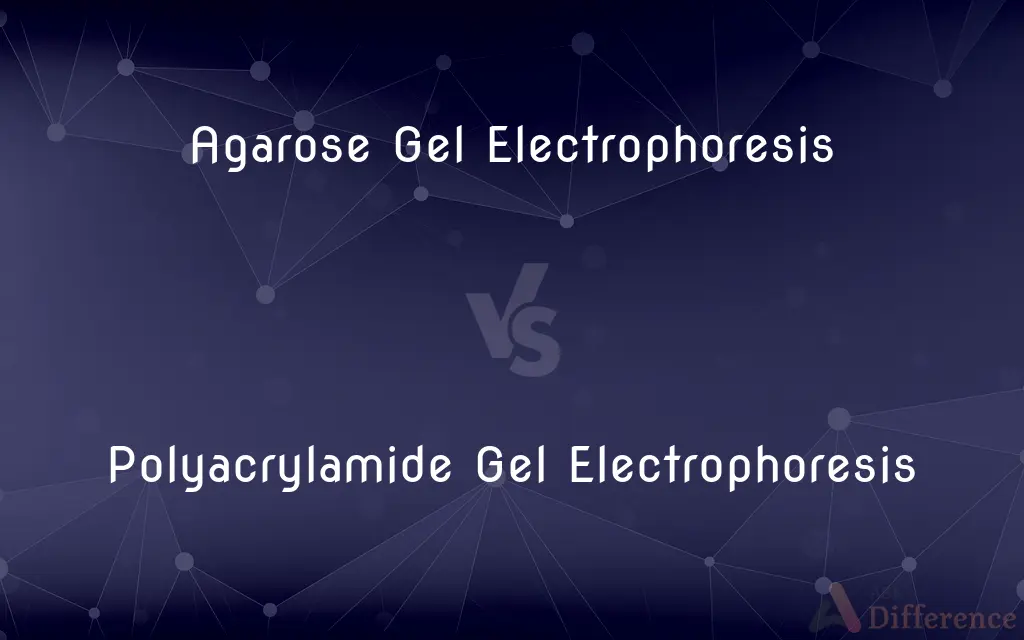Agarose Gel Electrophoresis vs. Polyacrylamide Gel Electrophoresis — What's the Difference?
By Tayyaba Rehman & Urooj Arif — Published on February 16, 2024
Agarose Gel Electrophoresis separates DNA or RNA molecules based on size, using agarose gel. Polyacrylamide Gel Electrophoresis (PAGE) separates proteins or small DNA fragments, using polyacrylamide gel, offering higher resolution.

Difference Between Agarose Gel Electrophoresis and Polyacrylamide Gel Electrophoresis
Table of Contents
ADVERTISEMENT
Key Differences
Agarose Gel Electrophoresis and Polyacrylamide Gel Electrophoresis (PAGE) are both techniques used in molecular biology to separate biological molecules but differ in their applications, resolution, and the types of molecules they are best suited to separate. Agarose gel electrophoresis is primarily used for the separation of DNA and RNA molecules. It utilizes agarose, a natural polymer extracted from seaweed, to form a gel matrix through which molecules can migrate when an electric current is applied. The separation is based on the size of the molecules, with larger molecules moving more slowly through the gel.
PAGE, on the other hand, is often used for separating proteins or very small DNA or RNA fragments. The gel is made from polyacrylamide, which allows for a more finely controlled pore size compared to agarose gels. This finer pore size provides a higher resolution, making PAGE more suitable for separating molecules that are very similar in size. PAGE can be run under denaturing conditions (SDS-PAGE) to separate proteins based on their molecular weight or under native conditions to preserve the protein's native charge, shape, and function.
The choice between agarose gel electrophoresis and PAGE depends on the specific requirements of the experiment. Agarose gels are easier to prepare and handle and are preferred for routine size separation of DNA fragments, such as in cloning or PCR analysis. PAGE provides greater resolving power for proteins and small nucleic acids, making it essential for applications like protein purification, identification, and analysis of protein complexes.
While agarose gel electrophoresis is generally safer and simpler to use, offering quick results for larger molecules, PAGE's ability to offer high-resolution separation makes it indispensable for detailed analysis of protein structure and function. The complexity of PAGE preparation and the toxic nature of acrylamide require careful handling and disposal procedures.
In summary, agarose gel electrophoresis and PAGE serve complementary roles in the molecular biology laboratory, with the choice of technique driven by the size of the molecules to be separated and the level of resolution required.
ADVERTISEMENT
Comparison Chart
Main Use
Separation of DNA and RNA
Separation of proteins and small DNA/RNA fragments
Gel Material
Agarose, a natural polymer
Polyacrylamide, a synthetic polymer
Resolution
Lower, suitable for larger molecules
Higher, suitable for molecules close in size
Toxicity
Generally non-toxic
Acrylamide is neurotoxic; care is required in handling
Application
Routine DNA/RNA analysis, such as checking PCR products
Protein analysis, identification, and studying molecular weight
Compare with Definitions
Agarose Gel Electrophoresis
A fundamental technique in molecular biology labs.
Agarose gel electrophoresis is a staple in our lab for DNA separation.
Polyacrylamide Gel Electrophoresis
Suitable for analyzing proteins by size and charge.
SDS-PAGE allowed us to determine the molecular weight of the protein.
Agarose Gel Electrophoresis
A technique for separating DNA or RNA fragments by size.
We visualized our PCR products using agarose gel electrophoresis.
Polyacrylamide Gel Electrophoresis
Provides detailed analysis of protein complexes.
Native PAGE was performed to study the protein-protein interactions.
Agarose Gel Electrophoresis
Ideal for analyzing large DNA fragments.
For the genomic DNA analysis, we used agarose gel electrophoresis.
Polyacrylamide Gel Electrophoresis
A method for separating proteins or small nucleic acids.
Polyacrylamide gel electrophoresis was used to assess the purity of our protein sample.
Agarose Gel Electrophoresis
Utilizes agarose gel as a medium for molecular separation.
Agarose gel electrophoresis was performed to estimate the size of the DNA fragments.
Polyacrylamide Gel Electrophoresis
Uses polyacrylamide gel for high-resolution separation.
We distinguished protein isoforms using polyacrylamide gel electrophoresis.
Agarose Gel Electrophoresis
Separates nucleic acids based on their molecular weight.
The restriction digest was analyzed by agarose gel electrophoresis.
Polyacrylamide Gel Electrophoresis
Requires careful handling due to acrylamide toxicity.
We took precautions while preparing the polyacrylamide gel due to its toxicity.
Common Curiosities
What molecules are best separated by agarose gel electrophoresis?
DNA and RNA fragments of various sizes.
Is agarose gel electrophoresis suitable for protein analysis?
No, it's primarily used for nucleic acids due to its lower resolution.
What is the purpose of SDS in PAGE?
SDS denatures proteins, allowing them to separate by molecular weight.
Can PAGE separate DNA fragments?
Yes, especially small fragments that require finer separation.
How does the pore size of the gel affect separation?
In agarose gels, larger pores separate larger fragments; in PAGE, the acrylamide concentration controls pore size for fine separation.
How long does electrophoresis typically take?
It can vary, but agarose gel electrophoresis usually takes 30-60 minutes; PAGE can take 1-4 hours.
When should I use PAGE instead of agarose gel electrophoresis?
For separating proteins or small nucleic acids that require high resolution.
Is special equipment needed for agarose gel electrophoresis?
Basic electrophoresis equipment, including a power supply and gel casting trays.
Why might I choose native PAGE over SDS-PAGE?
To analyze proteins in their native conformation or study protein-protein interactions.
What staining methods can be used with these techniques?
Ethidium bromide for nucleic acids in agarose gels; Coomassie Blue or silver stain for proteins in PAGE.
Are there alternatives to these methods for separating biological molecules?
Yes, other methods include capillary electrophoresis and chromatography techniques, depending on the specific application and resolution required.
What safety precautions are necessary for PAGE?
Handling and disposal of acrylamide require care due to its neurotoxic properties.
How do I choose the concentration of agarose for my gel?
The concentration depends on the size of DNA fragments you wish to separate.
Can I reuse polyacrylamide gels?
No, polyacrylamide gels are not reusable and should be disposed of properly.
Can agarose gel electrophoresis be used for quantitative analysis?
Yes, with appropriate standards and staining, it can be semi-quantitative.
Share Your Discovery

Previous Comparison
Cocamide DEA vs. Cocamide MEA
Next Comparison
Aperture vs. Shutter SpeedAuthor Spotlight
Written by
Tayyaba RehmanTayyaba Rehman is a distinguished writer, currently serving as a primary contributor to askdifference.com. As a researcher in semantics and etymology, Tayyaba's passion for the complexity of languages and their distinctions has found a perfect home on the platform. Tayyaba delves into the intricacies of language, distinguishing between commonly confused words and phrases, thereby providing clarity for readers worldwide.
Co-written by
Urooj ArifUrooj is a skilled content writer at Ask Difference, known for her exceptional ability to simplify complex topics into engaging and informative content. With a passion for research and a flair for clear, concise writing, she consistently delivers articles that resonate with our diverse audience.
















































